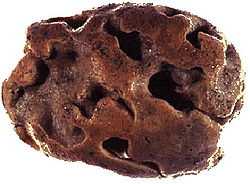Halichondria
| Halichondria | |
|---|---|
 | |
| Halichondria panicea | |
| Scientific classification | |
| Kingdom: | Animalia |
| Phylum: | Porifera |
| Class: | Demospongiae |
| Order: | Halichondrida |
| Family: | Halichondriidae |
| Genus: | Halichondria Fleming, 1828[1] |
| Species | |
|
see text | |
Halichondria is a genus of marine demosponges belonging to the family Halichondriidae.[1][2] These are massive, amorphous sponges with clearly separated inner and outer skeletons consisting of bundles of spicules arranged in a seemingly random pattern.
This genus of sponges became important through the discovery of cell division limiting properties of the extract Halichondrin B, which inhibits cell mitosis. The drug Eribulin, a related compound and an inhibitor of microtubule function, has become an important chemotherapy treatment for certain types of cancer.[3][4][5][6][7]
Species
|
|
References
- ↑ 1.0 1.1 van Soest, R. (2014). R. W. M. Van Soest, N. Boury-Esnault, J. N. A. Hooper, K. Rützler, N. J. de Voogd, B. Alvarez de Glasby, E. Hajdu, A. B. Pisera, R. Manconi, C. Schoenberg, D. Janussen, K. R. Tabachnick, M. Klautau, B. Picton, M. Kelly & J. Vacelet, ed. "Halichondria Fleming, 1828". World Porifera database. World Register of Marine Species. Retrieved 2014-04-30.
- ↑ A systematic revision of the central West Atlantic: Halichondrida (Demospongiae, Porifera). Part III: Description of valid species
- ↑ Towle, Murray J.; Salvato, Kathleen A.; Budrow, Jacqueline; Wels, Bruce F.; Kuznetsov, Galina; Aalfs, Kimberley K.; Welsh, Susan; Zheng, Wanjun; Seletsk, Boris M.; Palme, Monica H.; Habgood, Gregory J.; Singer, Lori A.; Dipietro, Lucian V.; Wang, Yuan; Chen, Jack J.; Quincy, David A.; Davis, Ashley; Yoshimatsu, Kentaro; Kishi, Yoshito; Yu, Melvin J.; Littlefield, Bruce A. (2 February 2001). "In vitro and in vivo anticancer activities of synthetic macrocyclic ketone analogues of halichondrin B". Cancer Research 61 (3): 1013–1021. PMID 11221827.
- ↑ Yu, Melvin J.; Kishi, Yoshito; Littlefield, Bruce A. (2005). "Discovery of E7389, a fully synthetic macrocyclic ketone analogue of halichondrin B". In Newman, David J.; Kingston, David G.I.; Cragg, Gordon M. Anticancer agents from natural products. Washington, DC: Taylor & Francis. ISBN 978-0-8493-1863-4. OCLC 57169963.
- ↑ Hirata, Yoshimasa; Uemura, Daisuke (January 1986). "Halichondrins - antitumor polyether macrolides from a marine sponge". Pure and Applied Chemistry 58 (5): 701–710. doi:10.1351/pac198658050701.
- ↑ Bai, Ruoli L.; Paull, Kenneth D.; Herald, Cherry L.; Malspeis, Louis; Pettit, George R.; Hamel, Ernest (25 August 1991). "Halichondrin B and Homohalichondrin B, Marine Natural Products Binding in the Vinca Domain of Tubulin. Discovery of tubulin-based mechanism of action by analysis of differential cytotoxicity data". The Journal of Biological Chemistry 266 (24): 15882–15889. PMID 1874739.
- ↑ Jordan, M.A.; Kamath, K.; Manna, T.; Okouneva, T.; Miller, H.P.; Davis, C.; Littlefield, B.A.; Wilson, L. (July 2005). "The primary antimitotic mechanism of action of the synthetic halichondrin E7389 is suppression of microtubule growth". Molecular Cancer Therapeutics 4 (7): 1086–1095. doi:10.1158/1535-7163.MCT-04-0345. PMID 16020666.